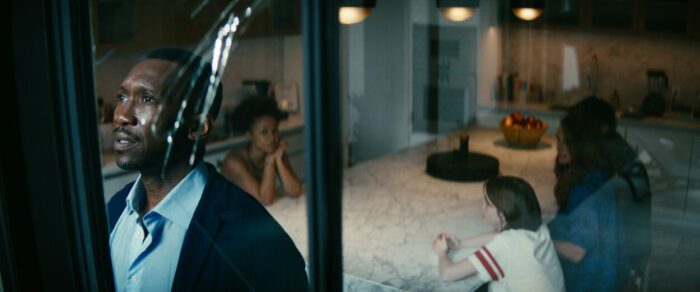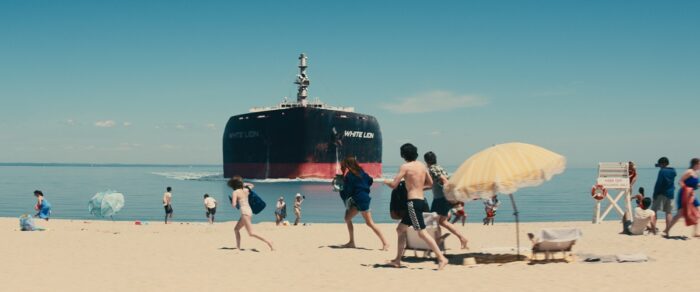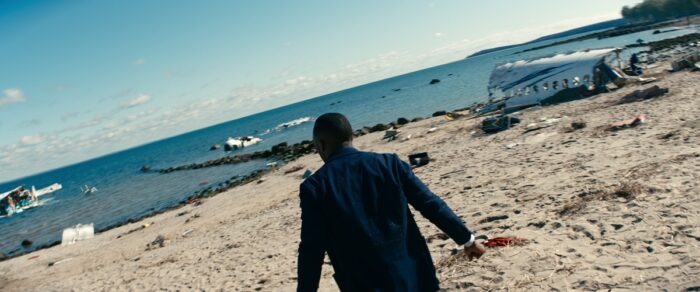Adapting Rumaan Alam’s 2020 novel with major creative liberties, Sam Esmail’s Leave the World Behind is a unique take on the disaster genre. Alam’s sci-fi bestseller (a finalist for the 2020 National Book Award for Fiction), chronicling the confrontations between two families during a global emergency, was serendipitously released at the height of the pandemic. It could not be more eerily and uncannily emblematic of COVID-19’s unprecedented lockdown–capturing the confusion and isolation experienced across the planet. In a recent interview on The Big Picture Podcast, Esmail notes how this focus on the nuclear family unit in Leave the World Behind fascinated him. He describes his film as operating in the opposite direction to the classic blockbuster disaster movie (i.e., Independence Day, Earthquake, The Towering Inferno, The Day After Tomorrow). Instead of focusing on the macro-cataclysmic spectacle, it fixates on micro-interpersonal transactions.
With this inverse focal point, Leave the World Behind eschews loud special effects and massive CGI-laden action set pieces to accentuate the dramatic dynamics of interpersonal frictions and parasocial prejudices. Instead of mass destruction and thrilling escapes, the film’s suspense revolves around conversational stand-offs and slow-burn hostilities. Sure, Esmail added a few inspired cinematic inventions to enliven the proceedings; for the most part, however, Netflix audiences are left unmoored while eavesdropping on private conversations, suspended in the eerie and disquieting calm of portentous waiting.
Invested in local human relationships, we are left as out of the loop as the characters. Gradually, through hearsay and inference, the natural presumption arises that cyber interference has occurred, but the details of who’s at fault, their intentions, and how the nation will respond are completely unavailable. Unlike the common trope in films like Armageddon or The Wandering Earth where a scientist spots a planetary threat in the form of a glitch in a statistical model, nothing is concrete in Leave the World Behind, forcing one to speculate and guess. This disconnect and informational impasse feels accurate to recent experience, mirroring how most civilians felt during the pandemic. It also gives Esmail’s tidily packaged genre experiment the indeterminacy it needs to explore contemporary hostilities, tensions, and sensibilities adapting and reacting to a catastrophic yet enigmatic event.
With Leave the World Behind, Sam Esmail not only departs in significant ways from the source novel (energizing the material with standout scenes featuring wayward oil riggers, leaflet-dropping mega-drones, and runaway Tesla vehicles) but he also leaves his familiar format in long-form series, where he’d spent the last decade or so proving his dystopian mettle by helming highly successful projects like Mr. Robot and Homecoming. While the loose literary adaptation feels like an obvious extension of Esmail’s signature themes (emphasizing cybersecurity, slippery psychological biases, and shadowy governmental/institutional hierarchies), it is a distillation of his narrative obsessions and largely devoid of the contours and complexities of a multiple-episode/season TV series.
Here, everyone feels like a short-handed cipher of an idea—an archetype devoid of multi-dimensionality. And yet, this is not necessarily a fault of the film or screenplay. In fact, the flatness of the characters feels apropos. With a tinge of ironic flair, their predictable opinions, reservations, and scenarios feel historically authentic. Far from unrealistic, everyone is a recognizable avatar–a personality defined by our terminally connected yet physically separated lifestyles. In many ways, the characters (largely inspired by the novel but also expanded upon) capture how digital media and technology obfuscate the realities on the ground, reducing our beliefs and identities to secondhand signifiers and unfounded assumptions.
The mere contemporariness of the characters and the backdrop of an ill-defined techno-crisis resembles the strangely paranoiac state of our labyrinthine digital age, where everyone is attuned to deceptive semiotic networks. This unnerving familiarity gives Esmail the cultural foundation necessary to elide and skip over the minutia of backstories, and to do so without making the characters feel shallow and cursory. It’s not hard to intuit why Amanda (Julia Roberts) is a misanthropic Karen who inveterately sees the worst in everything or why Ruth (Myha’la Herrold) is an entitled brat who prissily plays victim despite belonging to the upper echelon of society. And while George (Mahershala Ali) and Clay (Ethan Hawke) may be less cynical stereotypes, they are equally proxies for cultural and narrative constructs. As conduits for plot developments, they are fortuitously employed with professional insights that allow for crucial expositional dumps the screenplay needs to fill in the blanks.
A World of Premade, Semiotic Assumptions

Personal attributes are not the only shortcuts Esmail uses to drop insightful clues into his ensemble of characters. Minor details are fastidiously selected—from the wardrobe to the Old Westbury mansion’s design to the liquor cabinet’s fancy libations. Take the fashion: Clay’s Bikini Kill shirt indicates he’s a hip, woke feminist; his daughter, Rose, wears a NASA shirt, hinting at her intelligence and airiness (she, indeed, is somewhat of an adolescent space cadet); his son, Charlie, rocks an Obey t-shirt, a teenage status symbol and a canny allusion to John Carpenter’s They Live (a classic social satire that shares similar suspicions toward technology). Furthermore, consider the rental home’s painting of waves, which, according to a recent ScreenRant article, grow larger and larger throughout the film.
Whether intentional or not, the overloaded symbolism of everything (the props, costuming, staging) reinforces the presence of cultural signposts and semiotic social networks. This taps into the film’s glaring subtext, which pivots on how devices, technologies, clothes, and cultural narratives mediate and define modern life. Setting up these thematic underpinnings in stilted dialogue, Clay summarizes a colleague’s prosaic theory of media as both “an escape and a reflection” in the Leave the World Behind‘s first act. Clumsy exposition is rarely interspersed for nothing; Esmail, via Alam, is clearly commenting on the role of media in the movie.
At the same time, this notion of media feels at odds with the narrative of Leave the World Behind. It overlooks the critical function of media as an imposition—preying as it does on human vulnerabilities (fear, insecurity, loneliness) to reinforce and manifest premeditated pathologies. As such, media is more of a transmission than a reflection and more of an inculcation than an escape. Mediated in all directions (by professional duties, by zeitgeist philosophies, by entertainment), the modern world and those who exist within it are compelled to adopt external instruments and ideas at every turn, parroting these physical and metaphysical gadgets as gestures of false individuation.
We see the indoctrinating power of media throughout Leave the World Behind. Every character’s outlook appears to be largely mediated by the mores of social media and late-stage capitalism. Amanda is a disillusioned therapist—having observed human pettiness and narcissism so intimately and thoroughly, she can’t see anything else. Ruth is an emblem of performative disenchantment and disenfranchisement—she’s visibly ultra-affluent and coddled and yet selfishly filters every circumstance and relationship into a narrative of grievance. Put these two personality types in the same room, and conflict transpires, as Amanda’s cynical worldview and racially-tinged microaggressions trigger Ruth’s already flammable sense of umbrage and indignation.
Not everyone is quite so incendiary and flammable. As a financial advisor/analyst, George skirts so closely to the insidiously evil, upper-crust cabal running the world that he is burdened by his proximal inkling of ominous economic patterns and undisclosed political secrets. As the relaxed father who acquiesces to his wife’s wishes and begrudgingly goes with the flow, Clay is an amiable albeit spineless tenured professor—pragmatic and empathetic when it comes to issues of interpersonal conflict yet easily overwhelmed and lured into selfishness (fleeing the hysterical Spanish woman) and philandering (flirting with Ruth) by default of cravenness.
Amanda and Clay’s kids are even more tractable and ordinary. Rose (Farrah Mackenzie), the daughter in the Sandford family, is quirky and instinctive (Ruth astutely compares her to Donnie Darko, another eccentric kid character with apocalyptic premonitions). In one sense, Rose is compulsively detached from the reality around her, constantly seeking solace and emotional attachment in the popular yet artificial escapism of Friends; in other sense, she’s the keenest and most percipient of anyone in the family.
During a funny exchange early on, Rose asks her father if they can visit the fictional Central Perk café in Friends, learning to her dismay that it is not a real location in New York City but a soundstage. This tidbit forebodingly winks at the ongoing rift in the film between imagined simulacrum and actual reality. A parallel comedic conceit is Rose’s compulsive need to watch the last episode of the iconic sitcom series. Again and again, we witness her attempts to find a way to finish the series finale on multiple devices. With unexpected poignancy, this borderline neurotic preoccupation with finishing the series sets up the climactic punchline.
Meanwhile, Rose’s older brother Archie (Charlie Evans) is a credibly average, self-involved teenage boy. Besides losing his teeth (due to an act of sonic terrorism), Archie serves little purpose for the narrative despite rounding out the Sandford family. He is constantly on his phone (still taking voyeuristic pictures after cell service and Wi-Fi have vanished), consistently riling up his sister and instantly horny for Ruth.
The one commonality between the two Sandford siblings is their relationship to technology. From the opening shot of the two siblings glued to their iPad screens in the backseat to Amanda’s stilted line that they’ve already “moved onto the next episode” after an oil rig terrifyingly runs aground where the Sandford family is sunbathing, digital media serves as a metaphor for their sense of emotional detachment and as a means of cathartic abstraction.
Even side characters in Leave the World Behind, like Danny (Kevin Bacon), serve as ciphers that can be easily decoded. Danny is a radicalized conspiracy theory acolyte— the sort of conservative Reddit user who also passed as a cantankerous and hardened middle-class dad. Inhabiting a persona that both predates social media while remaining symbolic of how it can distort certain predispositions, he seems to be tethered to specific informational systems—even as he tries to flaunt cold-blooded libertarianism.
Danny functions as a conspicuously sinister symbol of ruthless isolationism: a two-dimensional yet somewhat believable paranoid schizophrenic who proves to be vindicated by the dystopian circumstances of the inchoate invasion; he’s a Rousseau/Machiavelli-style survivalist with a shotgun in hand and a foreboding skepticism, territorial callousness, and doomsday-prepper weariness shaping his standoffish perspective.
Automation on Autopilot

The nature of the inciting social disturbance—a nebulously understood cyberattack—creates yet another sort of intermediary interference insofar as the technologies mediating everyone’s lives are rendered useless and potentially deadly. The world has become increasingly erratic, from automated Tesla Model 3’s piling up on the highway to oil tankers and airplanes losing control and crashing explosively on ocean shores. Including these scenes is necessary, adrenalizing the film with a sense of imminence and exigency. Yet, Esmail’s deftness at capturing larger-scale action and staging it efficiently is somewhat shaky. The novice quality makes sense: he is working in relatively new territory.
In Mr. Robot and Homecoming, Esmail showed remarkable skill at framing and staging static situations. As gripping as Mr. Robot can be, it is rarely kinetic. The series mostly comprises long conversations in aesthetically rich, visually dynamic, and mysterious settings. With startling versatility, Esmail shows an impressive knack in Mr. Robot for framing stationary moments in novel, exciting ways: using crisp cuts, stark geometric slopes, lower quadrant framing, canted tilts, and precipitous angles to evoke a trippy, disorienting, and oppressive uneasiness. Deviating from cinematographic norms, the hacker-centered series is a masterclass in creating sinister and alienating moods with negative space.
In Homecoming, Sam Esmail works mostly in therapy sessions and corporate/bureaucratic spaces. As beautifully analyzed in Adam Nayman’s “How to Understand the Visual Style of Homecoming,” the Prime Series heavily taps into the “palette of 1970s paranoia cinema, using framing, camera movement, and sound to create an uneasy, modern (and near-future) world all its own.” In the same article, Nayman connects an opening needle drop (Pino Donaggio’s satirically overwrought score from Dressed to Kill) as a subtle foreshadowing of the entire series, given that Brian De Palma’s 1980 thriller, like Homecoming, revolves around a psychiatrist with a dark secret.
Esmail’s showmanship doesn’t relent throughout the entire first season. The credit sequences at the end of each episode all feature static, overhead long-shots of wherever the very last scene took place, jarringly removing the viewer from the tension of the narrative temporal mode into the prolonged banality of everyday temporality. The recurring flash-forwards are shot in a 1:1 aspect ratio, evoking a picture within a picture (i.e., a story within a story). The most iconic visual motif is ostensibly the recurring aerial view vantage point Esmail privileges, flattening the setting into an abstraction: an impressionistic canvas of positive and negative space.
Esmail’s bravura behind the camera and proclivity for overhead shots are similarly displayed in Leave the World Behind. The camera routinely glides across space or hovers above the characters, omnisciently eavesdropping at will. This is first captured in the car ride to Long Island, wherein the camera slowly and elegantly moves from Amanda in the passenger seat toward Clay (who is driving) before slowly creeping into the backseat. Inside the rental property, this panache is continued as Esmail tracks Amanda exploring the huge mansion via a crane shot that spirals overhead in disorienting maneuvers. Later, a similar bird’s eye view is created as the camera pulls out from the Tesla pile-up to show an endless pile-up on a parallel freeway and smoke billowing in Manhattan in the distance.
Nevertheless, the first impression from Esmail’s action scene choreography is that he’s somewhat out of his element. Oddly static and detached, the scenes are shot from a distance that somewhat flattens the visceral intensity. Upon further reflection, this might be by design: Perhaps the unconventionality of Leave the World Behind’s more lively scenes (the oil rig pummeling coastal sands, the drone slowly approaching Clay’s SUV, the same SUV dodging a rogue Tesla fleet) is an auteurist feature and not a hacky bug. It is possible that Esmail, in synthesis with his desire to keep the film localized and human-centered, pulls away and remains still on purpose, hoping to show how these macro-moments of mechanically fleeing are not what define the characters; by shooting them from afar, they remain background spectacle; they are titillating bursts of disaster entertainment, but not the crux or cynosure of the story.
The Reemergence of Raw Human Nature During the Demise of Technology

Due to a massive disruption of the networked infrastructure, the satellite systems, and the computerized status quo, objective devices and subjective information systems have collapsed, forcing everyone to confront their dependencies on prejudicial/informational comforts and various technologies. As the material conveniences (cars, social media systems, cash, economic markets) no longer uphold their preexisting purpose, the tension of selfhood mounts. Everyone’s solipsistic, media-defined defense systems have been breached. The question thus becomes what happens as ideological bubbles pop and tech proves obsolete at best and possibly even dangerous.
The narrative endgame quite legibly and coherently reflects its title: will the characters leave the world behind entirely, or will they leave the “old” world behind and start over? It is an old-fashioned test of human cooperation: an examination of the extent to which automated routines and indoctrinated Internet hives have become inculcated by cultural and institutional bodies. Like the long list of disaster films preceding it, Alam and Esmail probe how contemporary value systems and personality types might function during an existential threat. Unlike previous iterations, however, the fussiness and prickliness of our pampered age take center stage. Given the resurgence of cultural sensitivities and firebrand-fueled divisiveness, the traditional dilemma and interpersonal stakes feel heightened, fraught, and fresh.
At its core, Leave the World Behind wonders whether humanity can evolve. Does it have the propensity to develop new social and parasocial matrices? What aspects of human nature will materialize under various states of uncertainty, panic, and distress if not? Will the collapse of reliable information hierarchies exacerbate social, racial, economic, and cultural divisions, or will social stereotypes and biases be upheaved and corrected by the more pressing and primal need to survive in a state of civic instability? Will new philosophical fidelities emerge in the face of social groundlessness and fragmentation? Will the shared trauma and collective vulnerabilities from external threats tighten bonds? Will they magnify hostilities? Will the empty signifiers of a hyper-mediated and identity-centered world erode, sublimate, or persevere, transferring into a new operational nexus?
Though merely conjecturing in a pivotal monologue, George intuits that the vague and unspecified enemies behind the cyberattack are banking on continued social disharmony and corrosion. Summarizing a novel weapon system that he’d heard outlined by an uber-wealthy client, George describes a pioneering and cost-effective three-pronged cyberattack strategy that entails:
- Step 1: A widespread cyberattack on technological networks and satellite systems, launched to isolate citizens from a centralized authority or military body.
- Step 2: The insemination of pervasive uncertainty and chaos via misinformation campaigns (I.e., The propaganda-riddled leaflet a drone drops on Clay).
- Step 3: Civil and social collapse. Internecine warfare.
With the groundwork for this conventional divide and conquer campaign explicitly delineated with a new cyber twist, the question left at the end of Leave The World Behind is preemptively implied: taking a misanthropic stance, the material seems to view the worst in people. It foresees society savagely and cannibalistically turning inward, feasting on itself during a political, economic, and governmental vacuum.
The unfortunate part of the film’s brevity is the need to gloss over significant emotional and dramatic beats. In the film, George’s wife/Ruth’s mother is on a flight home from Morocco, and after witnessing multiple planes crash (ostensibly due to programmable glitches in their navigational systems caused by the cyberattack), they both seem to realize she is dead. The dramatic resonance this needs is overlooked and brushed aside whereas a series like Mr. Robot or Homecoming would have the space to give it the depth and weight it deserves.
One could easily imagine many of the major events turning into standalone episodes: an episode on the trip to the beach, another on the drone and leaflet incident, another giving the full backstory of Danny. Whether you prefer to have a condensed or elaborate story will go a long way in determining your preference, but for a film that revolves around the layers of human belief, bigotry, and disposition, some aspects feel rushed and underdeveloped.
Leaving One World Behind & Building Another

Nevertheless, the succinctness imbues the screenplay with a universality, painting its thematic contradictions and paradoxes in broad terms. As far as the screenplay is concerned, the best bet in a world where information is scarce (as doubt, fear, and ignorance are disseminated via mass disinformation) is to fortify oneself in a bunker and wait for an institutional resurgence. This is a common apocalyptic-teleological vision for modern storytelling. Still, it seems oddly in friction with the film’s other indictment of technological, social, and institutional automation, which dehumanizes by stripping away humanity’s aptitude, control, and agency.
Like the migrating flamingos and spooky flock of deer, a primary and overlying implication weaved throughout the film is the notion that humans lack free will. From the stock market’s uncontrollable capriciousness to the steady decline of human aptitude in the emergence of technological advances and computerized transportation, we are subject to immovable agendas, smarter devices, cultural stereotypes, and market patterns. These capitalist products and sociopolitical forces overshadow our lives—paralyzing our growth, independence, and overall skillfulness in the world.
By adopting the principles of the zeitgeist and the tools of consumerism, we become capitalist cogs—physically and intellectually. Yet, at some antediluvian point, our ingenuity did not enslave us. We once overcame our differences to create these systems. We overthrew the chaos of tribalism and devised social contracts to reconcile warring factions into a makeshift and democratic equilibrium that granted everyone a degree of safety, security, and autonomy. Thus, when understood as a parable for the end of modern systems, the predicament could just as easily be read as an auspicious opportunity: a chance to rectify and reform the world anew.
This existential crisis circuitously recalls Rose’s recitation of an overtly allegorical episode of the West Wing from the Sorkin years. In her recap, Rose paraphrases a plot line that mirrors the movie. It details a religious zealot who ignores multiple warnings to flee from an imminent flood due to an irrational reliance on God’s guardian oversight. When the man dies, he goes to Heaven and asks God why he didn’t protect him, upon which God explains he sent a messenger and a helicopter, but the man refused to heed his commands. Clearly, the story’s moral is to have faith in humanity and not passively wait for divine intervention. The true path of righteousness requires willpower and agency. It is essential to seize control of life directly, intelligently, and sensibly, reacting to environmental warnings and circumstances with cunning, openness, logic, and liberality.
As a synecdoche for the film itself, this parable synchs well with the subtext while playfully foreshadowing a false ending on its surface. Ultimately, Leave the World Behind is not rooted in pragmatic questions of fight or flight—instead, it is focused on questions of nihilism and faith. On a literal level, Amanda’s knee-jerk and reactive approach to the nebulous state of affairs is the most precarious stance; as it turns out, fleeing in a panic only makes the Sandford family more susceptible to the mass chaos erupting across the highways and cities. Alternatively, staying stationary, building news bonds, and hunkering down appears to be the more practical option to outlast the hypothetical civil war on the horizon.
The ethical implication here is not a matter of prudential policy but of existential dexterity and communal integrity. The key in a crisis is not to automatically retreat to comfort responses or to recoil to selfish instincts. To survive, one must steer the wheel manually while collaborating with like-minded individuals. To regain a state of society, one must heed philanthropic impulses, lead with the heart and brain, form intimate interpersonal bonds, sacrifice certain privileges, defend contractual obligations, make amends after disagreements, forge symbiotic relationships, and work together to maintain a humane ecosystem on the merits of goodwill and mutual respect and empathy. Instead of privately fleeing in fear, fortifying a robust and adaptable family structure is exponentially wiser.



